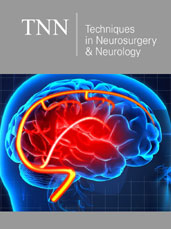- Submissions

Full Text
Techniques in Neurosurgery & Neurology
Conservative Oxygen Therapy is Better in Critically Ill Covid-19 Patient’s
Famitafreshi H and Morteza Karimian*
Department of Physiology, Iran
*Corresponding author: Morteza Karimian, Department of Physiology, Iran
Submission: April 14, 2021;Published: June 08, 2021

ISSN 2637-7748
Volume4 Issue3
Keywords: COVID-19; ARDS; Oxygen; Therapy; ICU
Opinion
Oxygen therapy is one of the most famous therapies in critically ill patients with different causes [1]. However, high-pressure oxygen therapy is associated with some advantages and disadvantages [2]. This issue may guide the attention to consider this therapy with careful considerations. However, when the situation is critical health care providers may consider these problems insignificant [3]. Maybe, the most important problem and question in this regard are to consider the pros and cons of this therapy in different concepts. At present time every person will consider that oxygen therapy is essential to critically ill patients without considering the side-effects. The most motivation for the presentation of this article is the recent observations in COVID-19 patients and seeing that there is a wide discrepancy among the time of death in individuals that receive oxygen that is in ICU (Intensive Care Unit) [4]. Some of them will die in a short time and some after a long time. So, it can be considered that individuals respond to oxygen differently when other factors will not be considered. ARDS (Acute Respiratory Distress Syndrome) is considered as the end-stage form of COVID-19 infection and usually, oxygen will be considered for these patients at high doses. On the other hand, this therapy has been associated with some serious effects. These serious side-effects will eventually cause considerable damages and compromise lung function. Studies show high-pressure oxygen therapy will cause some substructures damages that eventually will negatively influence oxygen therapy. They have included the emergence of adhesion molecules, recruitment of neutrophil, macrophage dysfunction, and production of chemotactic proteins [5,6]. Also, the production of oxygen-free radicals is one of the most serious side-effects [7]. Although some treatments have been considered for the alleviation of the case such as administration of interleukin receptor blockers [8] but oxygen, in any case, should be administered. Recent studies suggest the application of conservative therapy is advisable, however more studies are recommended for helping health care to implement more precise oxygen therapy. This is important in critically ill COVID-19 patients because high-pressure oxygen may be the only effective therapy for end-stage patience but the important issue, in this case, is considering that avoiding early high-pressure oxygen in the early stages of therapy seems reasonable. Keeping in mind that many COVID-19 patients, even hours before death are highly oriented, and the respiration is not deeply compromised and unfortunately all of them are highly ventilated. High ventilation may negatively predispose patients to develop more rapidly ARDS. So, considering the above facts, the application of highly controlled oxygen may be more helpful in patients, and high-pressure oxygen therapy may negatively more rapidly compromise lung function.
References
- Angus DC (2020) Oxygen therapy for the critically Ill. NEJM 382(11): 1054-1056.
- Machado HS (2017) Paradigms of oxygen therapy in critically Ill patients. Journal of Intensive and Critical Care 3(1): 3.
- Scala R (2014) High-flow nasal oxygen therapy: one more chance for extubation? Respiratory Care 59(4): 609-612.
- Gibson PG, Qin L, Puah SH (2020) COVID-19 acute respiratory distress syndrome (ARDS): clinical features and differences from typical pre-COVID-19 ARDS. Med J Aust 213(12): 54-56.
- Huang D, Fang F, Xu F (2016) Hyperoxia induces inflammation and regulates cytokine production in alveolar epithelium through TLR2/4-NF-κB-dependent mechanism. Eur Rev Med Pharmacol Sci 20(7): 1399-1410.
- Kotani N, Hashimoto H, Sessler DI, Muraoka M, Hashiba E, et al. (2000) Supplemental intraoperative oxygen augments antimicrobial and proinflammatory responses of alveolar macrophages. The Journal of the American Society of Anesthesiologists 93(1): 15-25.
- Zhang H, Slutsky A, Vincent JL (2000) Oxygen free radicals in ARDS, septic shock and organ dysfunction. Intensive Care Med 26(4): 474.
- Cavalli G, Luca G, Campochiaro C, Della TE, Ripa M, et al. (2020) Interleukin-1 blockade with high-dose anakinra in patients with COVID-19, acute respiratory distress syndrome, and hyperinflammation: a retrospective cohort study. Lancet Rheumatol 2(6): 325-331.
© 2021 Morteza Karimian. This is an open access article distributed under the terms of the Creative Commons Attribution License , which permits unrestricted use, distribution, and build upon your work non-commercially.
 a Creative Commons Attribution 4.0 International License. Based on a work at www.crimsonpublishers.com.
Best viewed in
a Creative Commons Attribution 4.0 International License. Based on a work at www.crimsonpublishers.com.
Best viewed in 







.jpg)






























 Editorial Board Registrations
Editorial Board Registrations Submit your Article
Submit your Article Refer a Friend
Refer a Friend Advertise With Us
Advertise With Us
.jpg)






.jpg)














.bmp)
.jpg)
.png)
.jpg)










.jpg)






.png)

.png)



.png)






